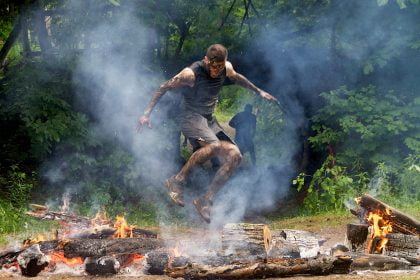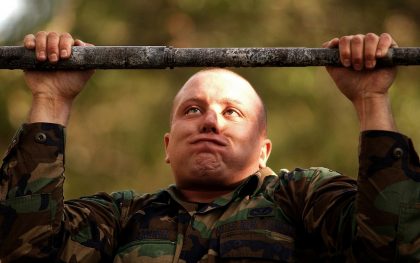Tick, tock, tick, tock… Time to get started in calisthenics — even if you’re a total beginner who’s not physically active.
Here’s an easy calisthenics routine for you to build basic strength and technique.
Basic Exercises & Progressions

There are five basic calisthenics exercises that work all your major muscle groups. These exercises build the foundation for advanced calisthenic and parkour feats.
And, they are…
- Push ups
- Pull ups
- Leg raises
- Squats
- Bridges
Each of these exercises has various progressions that have different levels of difficulty. For example, regular push ups are more challenging than wall push ups; full bridges are less easy to perform than straight bridges.
Adjusting the progression to your ability is the key to this routine. There’s no point in doing half-assed push ups with terrible form.
So, let’s take a look at the relevant progressions for this routine.
Exercise Progression Levels
The progression of each exercise is put in order of difficulty, from the most difficult to the easiest.
Because the guide is meant for newbies, the highest form of the exercise will be adjusted downwards. For instance, instead of designating handstand push ups as the highest progression, we’re using regular push ups.
Take The Test – Is the routine for you?

Before you get started, take this test to check if the routine is suitable for you. If you cannot complete the test in proper form, without use of momentum, this routine is for you.
Also, keep a record of how you did for the test. We’ll be using that score as a basis to improve your standard.
Test Standard
- Standard Push Ups – 3 sets of 9 repetitions
- Flat Leg Raises (aka. Lying Leg Raises) – 3 sets of 9 repetitions
- Regular Pull Ups – 3 sets of 3 repetitions
- Deep Squats – 3 sets of 9 repetitions
- Straight Bridges – 3 sets of 9 repetitions
For full instructions on how to perform the exercises (and see easier versions of each exercise), check out the section above.
If you’re unable to do an exercise, you fail. However, do try an easier version of it and record the number of repetitions you’ve performed.
In order to pass, you need to…
1. Maintain proper form throughout each exercise
You must perform all exercises with proper form. This means not arching your body when doing push ups, not kipping when performing pull ups, and so on.
All exercise movements must be controlled. You’re not allowed to use momentum, or bounces.
If you have to cheat to pass, you fail.
2. Limit your rest time between sets and breaks
Take no more than 2 minutes of rest between each set. And, no more than 4 minutes between each exercise. Anything more means failure.
Assuming you’ve failed, read on…
Calisthenics Routine for Physically-Inactive Beginners

Purpose
In thirty days, you are to improve your test standard. Bonus points, if you manage to pass, especially if you can’t already do pull ups. It usually takes more than 30 days to go from zero to 3 sets of three pull ups.
As long as you have a significant improvement from your previous score, good! You’ll be ready to undertake a higher standard calisthenics program for beginners.
Guidelines
Obviously, not everyone is beginning with the same ability and strength. So, here’s a simple rule…
Do your best to perform the standard form of the exercise. The moment you lose the correct form, drop to an easier progression of the exercise and continue.
For example, if you can no longer do standard push ups, do knee-supported push ups or inclined push ups. I’ve included a list of easy progressions in the previous section. Please refer to it.
Also, take 1 to 2 minutes break between each set of the same exercise. Take no more than three minutes to rest between different exercises.
Reduce your break times in the later weeks to make it more challenging.
Warm Up
Your warm up involves doing easier versions of the five exercises. So, whichever level of progression you’re at, drop one level when doing your warm ups.
For example, if you are able to do regular pull ups, do horizontal pulls as your warm up. Here’s the warm up plan. Again, the progression steps can be found in the previous section.
- Jog/Run – 3 to 5 minutes
- Push ups (drop one progression level) – 5 repetitions (2 sets)
- Pull ups (drop one progression level) – Horizontal pulls 5 repetitions (2 sets) / Active hanging 15 secs (2 sets)
- Leg raises (drop one progression level) – 5 repetitions (2 sets)
- Squats (drop one progression level) – 5 repetitions (2 sets)
- Bridges (drop one progression level) – 5 repetitions (2 sets)
The Routine
Pick the highest progression of each exercise that you can perform with proper form. At any moment you lose form, drop to an easier progression of the exercise, and continue.
For pull ups, it is acceptable to do halfway pull ups as an easier progression for full pull ups. So, for instance, if you find yourself struggling on your last pull up, just pull up as high as you can.
To reiterate, the highest progression for each exercise in this routine is as follows:
- Standard Push Ups
- Flat Leg Raises (aka. Lying Leg Raises)
- Regular Pull Ups
- Deep Squats
- Straight Bridges
Week 1
Do this routine on Day 1, 3, 5 and 6.
- Push ups – 3 sets of 6 repetitions
- Leg raises – 3 sets of 6 repetitions
- Pull ups – 3 sets of 3 repetitions (if it’s horizontal pulls aim for 3 sets of 6 repetitions)
- Squats – 3 sets of 6 repetitions
- Bridges – 3 sets of 6 repetitions
Rest on Day 2, 4 and 7.
Week 2
Same thing. But, we’re alternating the repetitions.
Do this routine on Day 1 and 4.
- Push ups – 3 sets of 6 repetitions
- Leg raises – 3 sets of 6 repetitions
- Pull ups – 3 sets of 3 repetitions (if it’s horizontal pulls aim for 3 sets of 6 repetitions)
- Squats – 3 sets of 6 repetitions
- Bridges – 3 sets of 6 repetitions
Do this routine on Day 2 and 5.
- Push ups – 3 sets of 9 repetitions
- Leg raises – 3 sets of 9 repetitions
- Pull ups – 3 sets of 3 repetitions (if it’s horizontal pulls aim for 3 sets of 6 repetitions)
- Squats – 3 sets of 9 repetitions
- Bridges – 3 sets of 9 repetitions
Rest on Day 3, 6 and 7.
Week 3
Same thing, except for pull ups. Increase repetitions. Halfway pulls are acceptable if you can no longer do full pull ups. Kipping is not acceptable.
Do this routine on Day 1, 2, 4 and 5.
- Push ups – 3 sets of 9 repetitions
- Leg raises – 3 sets of 9 repetitions
- Pull ups – 3 sets of 6 repetitions (if it’s horizontal pulls aim for 3 sets of 9 repetitions)
- Squats – 3 sets of 9 repetitions
- Bridges – 3 sets of 9 repetitions
Rest on Day 3, 6 and 7.
Week 4
This week is a five-day week. The routine on Day 4 and 5 goes beyond the test standard to challenge your strength.
Do this routine on Day 1, 2 and 7.
- Push ups – 3 sets of 9 repetitions
- Leg raises – 3 sets of 9 repetitions
- Pull ups – 3 sets of 3 repetitions (if it’s horizontal pulls aim for 3 sets of 9 repetitions)
- Squats – 3 sets of 9 repetitions
- Bridges – 3 sets of 9 repetitions
Do this routine on Day 4 and 5.
- Push ups – 3 sets of 12 repetitions
- Leg raises – 3 sets of 12 repetitions
- Pull ups – 3 sets of 6 repetitions (if it’s horizontal pulls aim for 3 sets of 9 repetitions)
- Squats – 3 sets of 12 repetitions
- Bridges – 3 sets of 12 repetitions
Take Day 7 of Week 4 as your test. This time round, you need to complete your warm up before attempting the test.
Over to You!

Your goal is to improve your test standard within 30 days. It doesn’t matter if you start the routine with easier versions of each exercise. What matters is that you’re building the proper calisthenics form and strength.
Moreover, since you’re beginning each session with the standard version of each exercise until you lose form, you’ll make big strides within the four weeks of training.
Ready? Set. Go!
Note: This calisthenics routine is inspired by the fundamentals in ‘Convict Conditioning’. To continue your training, I recommend the following program…
The Body Basic Training program
(School of Calisthenics)
Master pull-ups, dips, squats, and more. It’s all about movement, strength, and play.
This is my top recommended calisthenics program by the School of Calisthenics.











